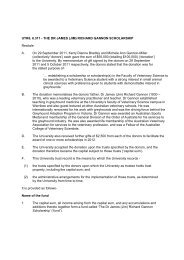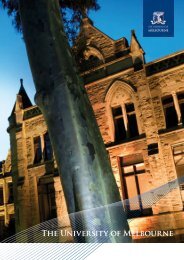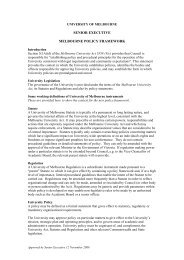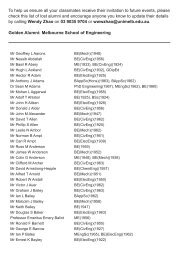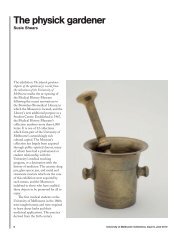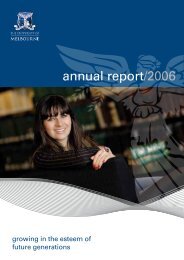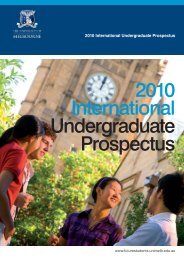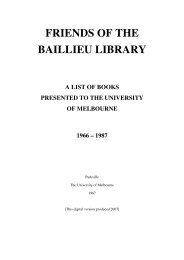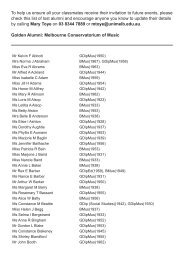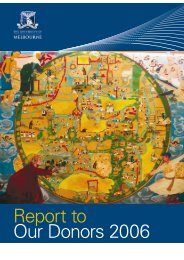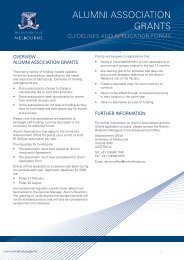2007 Annual report (PDF 8.1 Mb) - University of Melbourne
2007 Annual report (PDF 8.1 Mb) - University of Melbourne
2007 Annual report (PDF 8.1 Mb) - University of Melbourne
You also want an ePaper? Increase the reach of your titles
YUMPU automatically turns print PDFs into web optimized ePapers that Google loves.
Performance Against <strong>2007</strong> Targets (continued)<br />
Strengthen alumni relations<br />
The <strong>University</strong> launched the Alumni Web Community allowing alumni to register for a lifelong @alumni.unimelb email address. More than<br />
4500 are now registered. The audience for GradNet was expanded to over 40,000 alumni. Ways to transition to more regular and chiefly<br />
paperless communication with alumni were developed for implementation in 2008. A new alumni association was launched in China, a new<br />
alumni committee was formed in the USA and a new state branch is forming in Queensland.<br />
Achieve a student pr<strong>of</strong>ile and teaching revenue position that best<br />
prepares the <strong>University</strong> for the launch <strong>of</strong> the <strong>Melbourne</strong> Model in 2008<br />
DEST agreement for allocation <strong>of</strong> Commonwealth Supported Places to graduate students, together with the Federal budget decision to<br />
extend Youth Allowance and Austudy to students undertaking first pr<strong>of</strong>essional degrees at graduate level and rent assistance to students<br />
aged over 25, have ensured that students in the new <strong>Melbourne</strong> Model pr<strong>of</strong>essional graduate programs will not be disadvantaged and<br />
has expanded the pool <strong>of</strong> potential students. Consolidated income <strong>of</strong> $1.43 billion in <strong>2007</strong> was up by 11.7 percent on 2006, due largely to<br />
continuing growth <strong>of</strong> fee-revenue and research and investment income. A total fee revenue target <strong>of</strong> $279 million was exceeded by<br />
$14 million. A new budget model to be implemented in 2008 will provide support for <strong>Melbourne</strong> Model initiatives.<br />
Increase efficiency <strong>of</strong> <strong>University</strong> administration<br />
through academic and IT shared services implementation<br />
The <strong>Melbourne</strong> Student Services Model for student – centric administration was designed and significant progress made with<br />
implementation. Three projects will investigate ways to implement a decision to move $15 million in costs from administration to<br />
research activity over a three-year period. An external review <strong>of</strong> the <strong>University</strong>’s integrated administration system,Themis, provided<br />
recommendations to improve performance and utilise the latest technology. The IT Shared Services Service Framework was ratified with<br />
work underway towards a combined student IT Service framework. A comprehensive model was drafted for Information Services to<br />
enhance service performance measurement and implement improvement programs.<br />
Consolidate and adjust planning and budget processes<br />
which support the <strong>University</strong>’s strategic direction<br />
A revised planning framework ensures stronger sequencing and linkage between <strong>University</strong> and divisional levels, and between planning,<br />
budgeting, risk management, quality assurance and <strong>report</strong>ing. A new strategic risk framework and program focusses on identification, rating,<br />
mitigation and <strong>report</strong>ing. The program embeds risk management in business planning and review. The Risk Management Committee was<br />
re-constituted in December <strong>2007</strong> to provide greater strategic focus. Special risk programs made significant progress: EH&S risk was reduced<br />
through a budget penalty to divisions with poor performance; crisis simulation testing occurred and a continuity plan was developed.<br />
BINDING THE<br />
stranDS TOGETHER<br />
The three strands <strong>of</strong> the Growing Esteem<br />
Strategy connect and inform each other<br />
and are reflected in the structure and<br />
management <strong>of</strong> the <strong>University</strong>. The<br />
Strategy’s implementation depends on<br />
enablers that bind together the strands.<br />
These enablers: support for staff ;<br />
communications and marketing; campus<br />
infrastructure; finance and fundraising;<br />
planning and <strong>University</strong> administration<br />
help shape all aspects <strong>of</strong> the <strong>University</strong>’s<br />
activities. Growing Esteem efforts in <strong>2007</strong><br />
concentrated on preparing for the best<br />
possible transition to the <strong>Melbourne</strong> Model<br />
in 2008.<br />
People<br />
Implementing Growing Esteem involves an<br />
enormous amount <strong>of</strong> institutional change,<br />
in turn creating significant additional work<br />
for staff across the <strong>University</strong>. Ensuring<br />
that workloads remain manageable during<br />
the transition to the <strong>Melbourne</strong> Model has<br />
been a major focus <strong>of</strong> HR initiatives during<br />
the year.<br />
Full-Time Equivalent 2006 <strong>2007</strong><br />
Academic 3258 3371<br />
Pr<strong>of</strong>essional 3619 3778<br />
Total 6876 7149<br />
While national staff data is not yet available<br />
for <strong>2007</strong>, the <strong>University</strong> <strong>of</strong> <strong>Melbourne</strong><br />
was the largest employer in the higher<br />
education sector in Australia in 2006. The<br />
<strong>University</strong> <strong>of</strong> <strong>Melbourne</strong> also employs the<br />
largest number <strong>of</strong> academic staff on an<br />
equivalent full-time basis <strong>of</strong> all Australian<br />
universities. Growth in the number <strong>of</strong><br />
academic staff employed by the <strong>University</strong><br />
<strong>of</strong> <strong>Melbourne</strong> continued to outstrip that<br />
at the three next largest employers <strong>of</strong><br />
academic staff in the country: Monash<br />
<strong>University</strong>, the <strong>University</strong> <strong>of</strong> Sydney and<br />
the <strong>University</strong> <strong>of</strong> Queensland.<br />
In <strong>2007</strong> the <strong>University</strong> continued to comply<br />
with the Commonwealth Government’s<br />
Higher Education Workplace Relations<br />
Requirements (HEWRRs) through<br />
arrangements including the <strong>of</strong>fering<br />
<strong>of</strong> Australian Workplace Agreements.<br />
Compliance was essential to gain additional<br />
funding <strong>of</strong> 7.5 per cent in <strong>2007</strong> <strong>of</strong> the<br />
Commonwealth Grant Scheme.<br />
It is significant that at a time <strong>of</strong> great<br />
change, staff turnover figures have been<br />
running at or below their historic pattern<br />
over the past three years. Benchmarking<br />
staff data shows that in 2006 <strong>Melbourne</strong><br />
had a total staff turnover <strong>of</strong> 16.36 per cent,<br />
less than the Australian average <strong>of</strong> 19.02<br />
per cent and the Go8 average <strong>of</strong> 19.38 per<br />
cent. No time was lost through industrial<br />
action in <strong>2007</strong>.<br />
Ensure that the <strong>University</strong>’s<br />
employment policies and<br />
procedures reflect the<br />
goals <strong>of</strong> Growing Esteem.<br />
HR Strategy<br />
Strategic Priorities<br />
> Identify and implement recruitment,<br />
performance and promotion criteria<br />
which reflect Growing Esteem priorities<br />
including knowledge transfer






